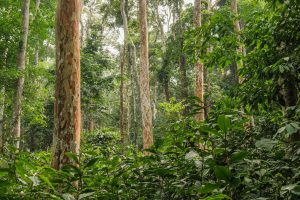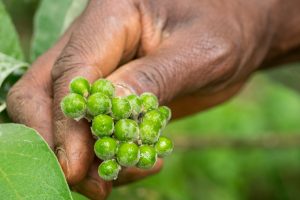At the Global Landscapes Forum (GLF) in Bonn, Germany, in December 2018, the CGIAR Research Program on Forests, Trees and Agroforestry (FTA) spoke with social entrepreneur Doreen Mashu, the founder of The Good Heritage in Zimbabwe – a wellness brand using non-timber forest resources to create products.
At the GLF, Mashu was part of the panel titled, “Delivery of quality and diverse planting material is a major constraint for restoration: What solutions, what emerging needs?”, hosted by FTA with Bioversity International, World Agroforestry (ICRAF), and supported by the Food and Agriculture Organization of the United Nations (FAO).
During the session, Mashu emphasized the need for a clear connection between restoration efforts and economic activity. “Companies are thinking about doing good in addition to making financial returns,” she said. Thus, business can be a vehicle for restoration for both businesspeople and the scientists who support it, she explained.
Read our interview with Doreen Mashu here, edited for length and clarity.
How is your business connected to nature and forests?
The Good Heritage is a startup, and it’s a company I founded recently. What I am really trying to do is take a back-to-basics approach to ‘nutrifying’ the world. We look back at some of the traditions and we borrow from them – some of these great traditions about using just the most natural forms of medicine, for example, or cosmetic products, or food products. I’m trying to bring to the world more consumer goods that are wellness-based, and are based from forests, and that are very natural, wild harvested, and in their most natural form. And I am aiming to make these more available to the global community.
Read more: The right species for the right purpose
How do forest products relate to the growing interest in wellness?
I think wellness is just this idea of feeling your best, whether it is the way you look, the way you feel, the way you think, or the decisions you make throughout the day to support your whole being. It’s a holistic view to what makes a person whole, and what makes them live their best life.
When I was looking at working with forests and creating opportunities around forests for communities, I realized that I needed to find a demand, a need to be met, through forests. And wellness is a growing trend globally. It’s potentially not even a trend, because it is something that is really here to stay.
People are moving away from cosmetic products, for instance, with multiple ingredients, in favor of things with minimal ingredients. As an example, one of our products is a cosmetic oil that you can apply, and that’s it. You don’t need another cream, you don’t need an eye cream, you don’t need all these other cosmetic products that you would normally need. We are basically meeting that need to simplify the beauty process for women and men around the world. This is certainly an area for me that is exciting, and that can be met through developing and restoring forests.

What barriers exist in restoring degraded land and achieving sustainable development related to forests?
I think that the main issue is connecting with communities and cocreating with the communities. I don’t think we’ll fix this problem by simply bringing solutions. I think that we need to connect the goals of restoring forests to development goals, to people’s needs.
I like ideas where you cocreate with the community, so you’re not bringing a solution from elsewhere. Bringing all these together will be a step in the right direction to meeting these goals.
Watch: FTA at GLF: Involving youth in restoration and conservation
How can the private sector engage in seed systems and land restoration?
The private sector plays a very big role. It needs to be at the table when scientists, researchers and the government are talking about restoration. And thanks to the Sustainable Development Goals (SDGs), the private sector is now thinking about ways to do good and implementing a multipronged approach of doing good for business, good for society and good for the environment.

The private sector needs to be front and center. In terms of financing, some financing can come through the private sector as long as they are also getting what they need and getting the financial returns that they need.
How can we move from restoration pledges toward restoration action?
Pledges are very interesting because sometimes people sit in a room and they come up with numbers. However, I think that they need to be constantly be updated with new information from the field. Sometimes, we have these big numbers that we want to accomplish, but we don’t really tie them to what’s happening on the ground. We really need to look at why we are trying to achieve something such as the restoration of however many hectares of land. What is the reason for this, and can we explain it in a way that we get buy-in from everyone that is involved?
By the FTA communications team.
The CGIAR Research Program on Forests, Trees and Agroforestry (FTA) is the world’s largest research for development program to enhance the role of forests, trees and agroforestry in sustainable development and food security and to address climate change. CIFOR leads FTA in partnership with Bioversity International, CATIE, CIRAD, ICRAF, INBAR and TBI. FTA’s work is supported by the CGIAR Trust Fund.











